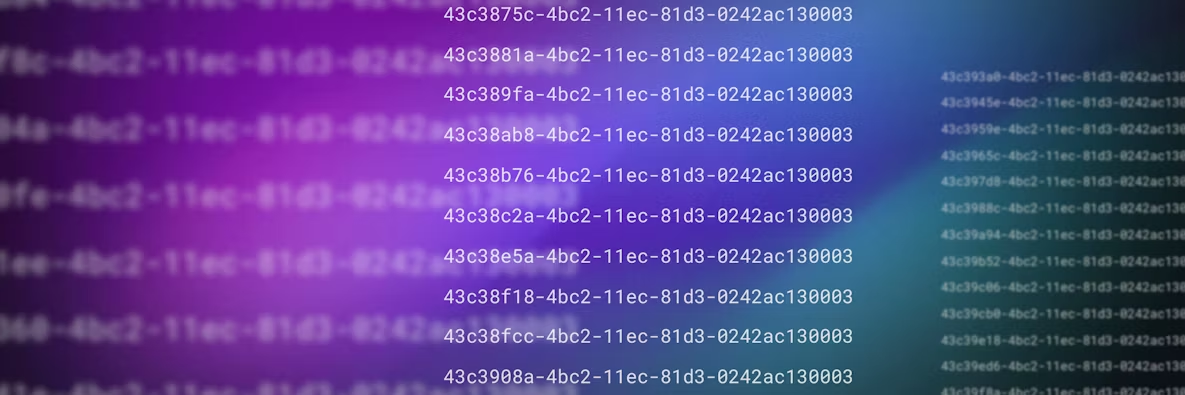Understanding UUIDs: Universally Unique Identifiers
 Cloud Tuned
Cloud Tuned
Understanding UUIDs: Universally Unique Identifiers
UUIDs, or Universally Unique Identifiers, are standardized identifiers used in computer systems to uniquely identify entities without requiring centralized coordination. In this article, we'll explore what UUIDs are, how they're generated, and their various use cases in software development.
What are UUIDs?
UUIDs are 128-bit numbers represented as a 32-character hexadecimal string, typically formatted in groups separated by hyphens, such as 550e8400-e29b-41d4-a716-446655440000. The uniqueness of UUIDs is guaranteed by the combination of timestamp, unique node identifier, and random or pseudo-random numbers used during generation.
Parts of a UUID
A UUID is typically divided into five parts:
- Time_low: The first 32 bits of the UUID represent the timestamp in Unix epoch time format.
- Time_mid: The next 16 bits represent the timestamp in Unix epoch time format.
- Time_hi_and_version: The next 16 bits represent the timestamp and version number.
- Clock_seq_hi_and_reserved and clock_seq_low: The next 8 bits represent the clock sequence and reserved bits.
- Node: The last 48 bits represent the node identifier, typically the MAC address of the generating host.
Types of UUIDs
There are several versions of UUIDs, each generated using different algorithms and sources of randomness. Some common types of UUIDs include:
- Version 1: Generated from a combination of the current timestamp and the MAC address of the host generating the UUID.
- Version 4: Generated using random or pseudo-random numbers, providing a high degree of randomness.
- Version 5: Similar to version 3 but uses SHA-1 hashing instead of MD5.
Examples of UUIDs
Here are some examples of UUIDs and their breakdown:
- Version 1 UUID:
550e8400-e29b-41d4-a716-446655440000- Time_low:
550e8400 - Time_mid:
e29b - Time_hi_and_version:
41d4 - Clock_seq_hi_and_reserved:
a7 - Clock_seq_low:
16 - Node:
446655440000
- Time_low:
- Version 4 UUID:
f47ac10b-58cc-4372-a567-0e02b2c3d479- Randomly generated with a high degree of randomness.
Note: Version 4 is known as the random variant because, as the name implies, the value of the UUID is almost entirely random. The exception to this is the first position in the third segment of the UUID, which will always be 4 to signify the version used.
Use Cases of UUIDs
UUIDs find applications in various fields and industries, including:
- Database Primary Keys: UUIDs are commonly used as primary keys in databases, especially in distributed or replicated systems, to ensure uniqueness across multiple nodes.
- Session IDs: UUIDs can be used to generate unique session IDs for web applications, enhancing security and preventing session hijacking.
- Message Queues: UUIDs are used as message identifiers in message queues and event-driven architectures to track message processing and ensure message delivery.
- Resource Identifiers: UUIDs are used as unique identifiers for resources in distributed systems, such as APIs and microservices, to avoid conflicts and collisions.
Conclusion
UUIDs are powerful tools for generating unique identifiers in computer systems, providing a reliable and decentralized approach to identity management. By leveraging UUIDs, developers can ensure data integrity, prevent conflicts, and enhance scalability in distributed systems.
Are you interested in learning more about UUIDs and their applications? Share your thoughts and questions in the comments below! Don't forget to subscribe to our blog newsletter for more informative content on software development, data management, and technology trends.
Unlock the power of UUIDs and streamline your data management processes with universally unique identifiers! 🔍🔐
Subscribe to my newsletter
Read articles from Cloud Tuned directly inside your inbox. Subscribe to the newsletter, and don't miss out.
Written by
